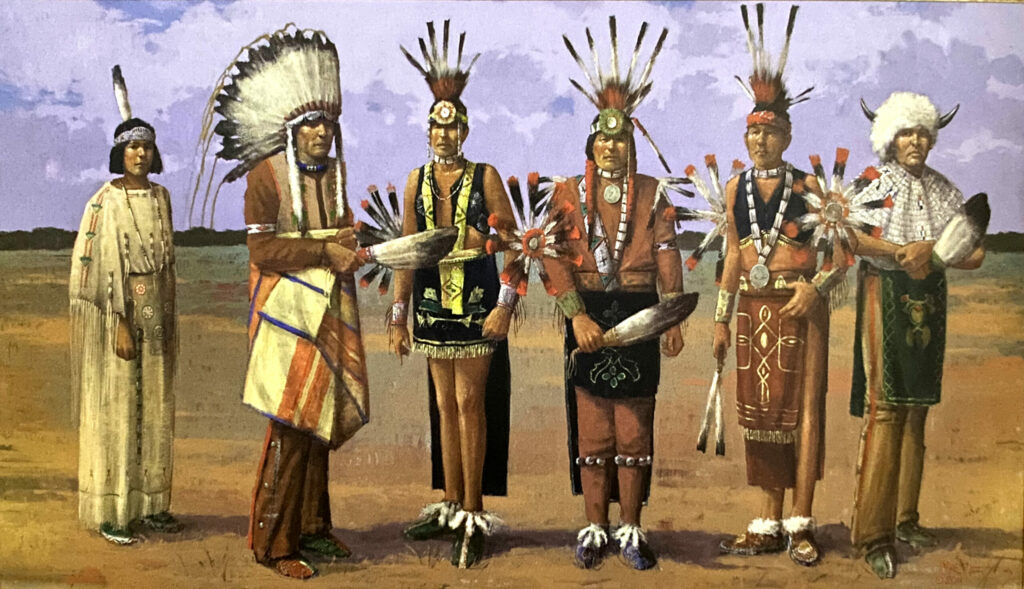Artist: Mike Larsen
For more than half a century, the art world offered reverence and veneration for the Kiowa Five, a group of young men who studied with Professor Oscar Jacobson at the University of Oklahoma. Their paintings garnered worldwide attention and contributed to a paradigm shift in the way Americans viewed Native Art.
What many don’t realize is that there were actually six young Kiowa artists who studied with Jacobson at the university in 1927. Justice Yvonne Kauger and the Oklahoma Judicial Center Art Committee took the opportunity to share the story of the forgotten Kiowa through the commissioned piece, Kiowa Six.
The sixth artist was Lois Bougetah Smoky, who was born near Anadarko in 1907. Her mother accompanied her to the University of Oklahoma. Decades later, Jacobson wrote about Smoky. “Her career in art was brief but happy, it reached its high point with the reproduction in color of one of her works in the volume, ‘Kiowa Art’ and with a feature story in one of the great Chicago newspapers. But it was soon over. She married and devoted herself to her young family, as is often the case with talented girls.”
Jacobson described her subjects as being primarily mothers and children. “All have great feminine delicacy and charm; they are also instinctively sentimental towards motherhood and childhood. Most of her paintings are harmonious arrangements of blue and yellow, the blue sky and the yellow grass of the great Plains.”
Jacobson also offered insight on the brevity of Smoky’s time at the university. “The painting of pictures was traditionally a masculine art among the Plains Indians. While the first Kiowa artists were in Norman, there was noticeable among the boys a certain resentment towards Lois for participating in such an unladylike activity. This resentment found expression in several small, unkind annoyances toward her, even to the extent of mutilating her work.” Because she created so few pieces, Smoky’s work is highly sought after by collectors.
Artist Mike Larsen recognized the importance of Smoky and gave her the place of honor in the group portrait. “With English, we read left to right, so the figure on the left is what draws your eye. The painting begins with her.” For the astute viewer, there are also other clues to the relationship of the artists. With the men, they are all touching, either their arms or shoulders or the feathers they are wearing. “They are all connected.” Smoky stands apart, alone. This placement is also intended to draw the viewer’s eye to her.
“Emotion is what I’m after in a painting,” Larsen said. “I discovered long ago that painting people was what supplied me with that venue to paint emotion. A lot of people do it through landscapes or with abstracts and color – vivid, bold sharp strokes of this or that, but the people are what tell the story for me. You can tell so much about a person, a man or a woman, by looking at their face or their hands. You can tell everything you need to know about that person. That’s what I try and paint and that’s where my truth comes from.”
Larsen toured the building in October 2010, while it was still under construction, taking pictures of the space and noting the color of the ceiling and surrounding walls. The mural’s companions in the second-floor reception area were created by two of the subjects in the piece, Stephen Mopope and James Auchiah. Larsen said he feels honored to be in such company. “The colors of the historic paintings are very similar to what I use… reds and blacks. Plus, with the background, the art really comes alive.”
James Auchiah completed the Indian Friendship mural on the opposite wall, for the Five Civilized Tribes Agency in Muskogee. Stephen Mopope painted the two Flute Dance murals for the library of Southwestern State Teachers College in Weatherford. Monroe Tsatoke designed and completed eight of the mural panels on the walls of the third floor depicting vanishing aspects of tribal life. Tsatoke died of tuberculosis before he could finish the project, so the last two panels were painted by fellow Kiowa Six artist, Spencer Asah. All of these murals were created during the 1930s under the New Deal public art programs. Jack Hokeah is the final member of the group. Oklahoma Judicial Center pieces by Auchiah, Asah, Mopope,and Tsatoke, along with their biographical information appear on the following pages. Artist Mike Larsen’s biographical information appears with his Metamorphosis piece on page 76.
